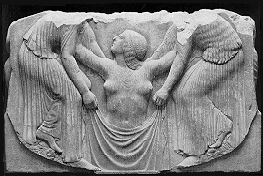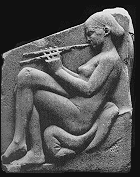 |
It seems likely that the Ludovisi Throne may show the birth of Aphrodite. The central figure seems to be helped up by attendants who are waiting to wrap her in a cloak or cloth, as seen on contemporary vase paintings. The central figure appears to be wet, and the attendants are standing on a pebble beach which is a rudimentary indication of a seashore. The attendants may be Horai (Seasons) who sometimes accompany Aphrodite on red figure vases, or Morai (fates). |
 |
The two figures on the side panels could illustrate the contrast between the two ways of serving Aphrodite. In literature and vase painting, a flute girl was commonly a hetaira (a courtesan), and the nudity of the figure (one of the first female nudes in Greek Art) stresses this. The veiled propriety could represent a matron or a priestess. This could stress the contrast between the two ways of serving Aphrodite: |
 |
| This seems to be the most likely reading of the Ludovisi Throne. If Aphrodite is represented, this would link the throne to the cults of Locri, to which the throne can also be stylistically linked. |